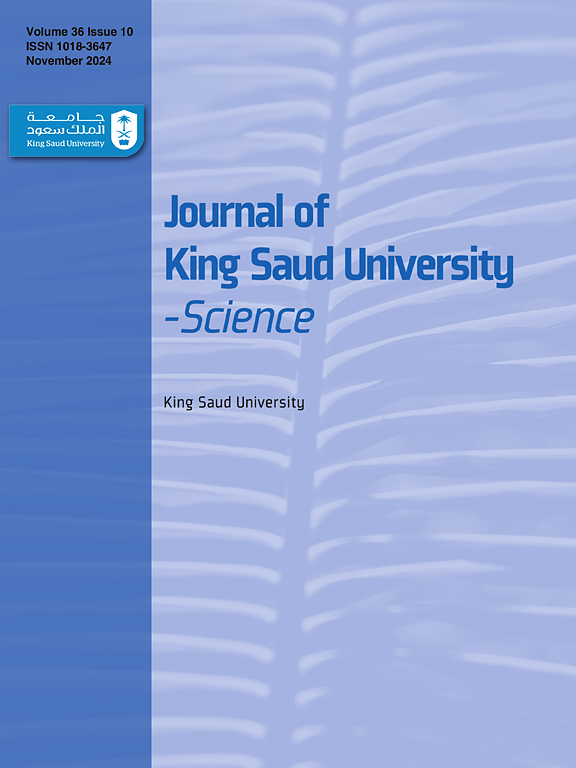Purification, characterization and molecular docking studies of analogous alpha amylase inhibitor compounds
IF 3.7
3区 综合性期刊
Q1 MULTIDISCIPLINARY SCIENCES
引用次数: 0
Abstract
Background
A large number of protein inhibitors are found in higher plants, cereals and legumes. These inhibitors are helpful in the prevention as well as medical treatment of metabolic syndromes such as type 2 diabetes. Basically, the diabetes mellitus is a chronic disorder that occurs either due to inadequate insulin secretions or when body fails to utilize the produced insulin. The alpha amylase inhibitors are termed as starch blockers. They catalyze the hydrolysis of α-(1,4)-D-glycosidic linkages of starch and other glucose polymer. They play a significant role in inhibition of the activity of salivary and pancreatic amylase in vitro and in vivo.
Method
The present study was based on the purification, characterization and molecular docking studies of the alpha amylase inhibitor isolated from the kidney bean sample. The seed sample was collected from G.B. Pant Nagar University. The crude extract was prepared, the in-vitro studies and heat stability were determined. Following it, purification was carried out using ammonium sulphate precipitation and size exclusion chromatography was done. Later, characterization and molecular docking studies of the purified sample was done after obtaining GC–MS results.
Result
The in-vitro analysis was done and noted that the inhibitory activity was 96.5 ± 0.84 % post size exclusion chromatography. The molecular weight was about 54 kDa. The molecular docking studies revealed that there were interactions between the ligand molecules (the constituents that were selected from the GC–MS chromatogram peaks based on the height and area) and the human pancreatic alpha amylase (1HNY). The hydrogen bonding as affinity binding capacity was also been observed in each of the ligand–protein interaction.
Conclusion
From the tests, it has been elucidated that the alpha amylase inhibitor isolated from the sample has a great potential to serve as an anti-diabetic drug. However, in order to check the potential effects and to explore the optimization and development of the anti-diabetic drug the in-vivo studies can also be done further.
类似α-淀粉酶抑制剂化合物的纯化、表征和分子对接研究
背景在高等植物、谷物和豆类中发现了大量蛋白质抑制剂。这些抑制剂有助于预防和治疗代谢综合症,如 2 型糖尿病。从根本上说,糖尿病是一种慢性疾病,是由于胰岛素分泌不足或人体无法利用产生的胰岛素而导致的。α-淀粉酶抑制剂被称为淀粉阻滞剂。它们能催化淀粉和其他葡萄糖聚合物的α-(1,4)-D-糖苷键的水解。本研究基于从芸豆样品中分离出的α-淀粉酶抑制剂的纯化、表征和分子对接研究。种子样品采集自 G.B. Pant Nagar 大学。制备了粗提取物,并进行了体外研究和热稳定性测定。随后,使用硫酸铵沉淀和尺寸排阻色谱法进行纯化。结果体外分析结果表明,经尺寸排阻色谱分析后,其抑制活性为 96.5 ± 0.84 %。分子量约为 54 kDa。分子对接研究表明,配体分子(根据高度和面积从 GC-MS 色谱峰中选出的成分)与人胰腺α淀粉酶(1HNY)之间存在相互作用。结论从试验中可以看出,从样品中分离出的α-淀粉酶抑制剂具有作为抗糖尿病药物的巨大潜力。不过,为了检验其潜在效果,探索抗糖尿病药物的优化和开发,还可以进一步开展体内研究。
本文章由计算机程序翻译,如有差异,请以英文原文为准。
求助全文
约1分钟内获得全文
求助全文
来源期刊

Journal of King Saud University - Science
Multidisciplinary-Multidisciplinary
CiteScore
7.20
自引率
2.60%
发文量
642
审稿时长
49 days
期刊介绍:
Journal of King Saud University – Science is an official refereed publication of King Saud University and the publishing services is provided by Elsevier. It publishes peer-reviewed research articles in the fields of physics, astronomy, mathematics, statistics, chemistry, biochemistry, earth sciences, life and environmental sciences on the basis of scientific originality and interdisciplinary interest. It is devoted primarily to research papers but short communications, reviews and book reviews are also included. The editorial board and associated editors, composed of prominent scientists from around the world, are representative of the disciplines covered by the journal.
 求助内容:
求助内容: 应助结果提醒方式:
应助结果提醒方式:


